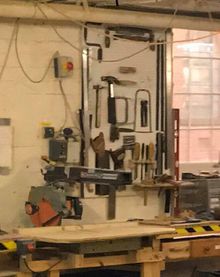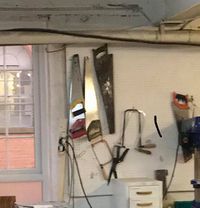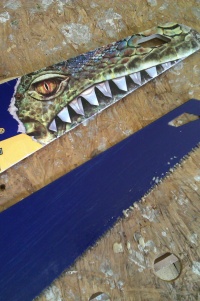Hand Saws: Difference between revisions
Jump to navigation
Jump to search
A new page, w00t |
tidy |
||
| (4 intermediate revisions by 2 users not shown) | |||
| Line 1: | Line 1: | ||
== | {{Tool | ||
|image=File:Tool_WoodHandsaws.jpeg | |||
|manufacturer=Various | |||
|model=Various | |||
|obtained= | |||
|obtaineddate= | |||
|location=Workshop | |||
|team=Woodworking | |||
|induction=No | |||
|defunct= | |||
|defunctdate= | |||
}} | |||
There are various hand saws around the space. | There are various hand saws around the space. | ||
== | == Workshop area == | ||
[[File:Tool WoodHandsaws2.jpeg|200px|thumbnail|right|More saws in the workshop]] | |||
In the [[Workshop]] there are the following saws: | |||
* Mitre saw (in jig under work bench) - for cutting specific angles such as 45° for making picture frames. | * Mitre saw (in jig under work bench) - for cutting specific angles such as 45° for making picture frames. | ||
* Tennon saw - for accurate wood working: e.g. joints. | * Tennon saw - for accurate wood working: e.g. joints. | ||
| Line 11: | Line 25: | ||
* Junior hack saw - most useful for smaller metal work. | * Junior hack saw - most useful for smaller metal work. | ||
* Coping saw - cutting intricate shapes with right curves. | * Coping saw - cutting intricate shapes with right curves. | ||
* Japanese pull saws - fine wood working. | * Japanese pull saws - fine wood working. | ||
{{clear}} | |||
==Usage== | |||
===Avoid=== | |||
[[File:Glued-up_Saw.jpg|thumb|right|200px|Gunked up saw prised out of its sheath]] | |||
If cutting through something covered in wet adhesive or resin fully clean the tool afterwards. | |||
Do not put unclean tool back into cardboard sheath. Otherwise the tool becomes struck in sheath and hard to clean.{{no}} | |||
== | {{clear}} | ||
== Resources == | |||
*[http://boingboing.net/2014/12/03/an-introduction-to-hand-saws.html Introduction to hand saws (Boing Boing)] - which ones to use for what jobs, technique and so on | |||
[[Category:Tools and Equipment]] | [[Category:Tools and Equipment]] | ||
[[Category:Woodwork]] | |||
Latest revision as of 10:28, 14 March 2019
| Hand Saws | |
|---|---|
 | |
| Manufacturer | Various |
| Model | Various |
| Location | Workshop |
| Team | Woodworking |
| Induction Required | No |
| Tools: all pages • list • Power Tools • Broken tools {{}} | |
There are various hand saws around the space.
Workshop area

In the Workshop there are the following saws:
- Mitre saw (in jig under work bench) - for cutting specific angles such as 45° for making picture frames.
- Tennon saw - for accurate wood working: e.g. joints.
- Cross-cut saw - cutting across grain in larger pieces of softer woods.
- Rip saw - cutting along the grain of in larger soft wood pieces.
- Hack saw - cuts metal, plastic & wood.
- Junior hack saw - most useful for smaller metal work.
- Coping saw - cutting intricate shapes with right curves.
- Japanese pull saws - fine wood working.
Usage
Avoid

If cutting through something covered in wet adhesive or resin fully clean the tool afterwards.
Do not put unclean tool back into cardboard sheath. Otherwise the tool becomes struck in sheath and hard to clean.![]()
Resources
- Introduction to hand saws (Boing Boing) - which ones to use for what jobs, technique and so on